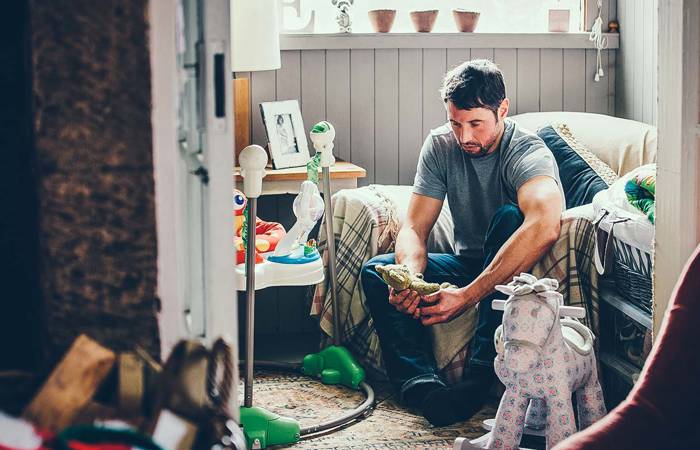Like what you see?
Sign up to receive more free parenting advice.
Thank you for subscribing to our newsletter!
Child Development

Credit: iStock.com/Yuricazac
Sleep deprivation and parenting all too often go hand in hand but one expert believes parents are being set up to fail with false promises of baby sleep training and misguided beliefs that magic routines will see their infants sleeping through the night.
Registered nurse, midwife and author of The Tresillian Sleep Book Fran Chavasse says too many people mistakenly believe that children can learn to sleep at any age.
“Children don’t learn to sleep. Sleep is a developmental process like walking and talking and it happens over time,” Fran says.
“Because it’s a development process for example, you wouldn’t expect a four month old baby to just get up and walk, you’d expect certain things to occur before they walk, like they’d roll, and they’d pull themselves up on their hands and knees and they’d rock around a bit. Then they’d go step by step. Sleep is a bit the same.”
Fran says parents are bombarded by information and false promises, but that she finds the most helpful thing is explaining sleep as a developmental process.
“There isn’t one size fits all. They do develop in their own time,” Fran says.
“It’s actually a team effort. It’s not just the baby, it is both the baby and parents that have to work this out together.
“Unfortunately parents often start out with expectations too high because of the plethora of information.”
Children don’t learn to sleep. Sleep is a developmental process like walking and talking and it happens over time.Registered nurse and midwife Fran Chavasse
Evaluate your sources of information
Fran encourages parents to look carefully at the source of the information being provided or the evidence behind the service being offered.
She says that sometimes information and evidence may be outdated.
“Things like controlled crying - that evidence is from a really long time ago when they said that you can condition children to do certain things. That is quite true. You can.
“You can condition children to learn to do stuff. You can condition them to stop crying.
“These methods are not about conditioning them to sleep. We are conditioning them to stop crying.
“So what they are doing is called an extinguishing method. They are behavioural methods. They are evidence-based but they are old evidence.
“What Tresillian does is use current evidence. From early brain development and attachment theory what we understand now from new and emerging evidence is that it is better to respond to your baby’s crying and do something about it because crying is a baby’s way of saying ‘I need your help’.
“It’s better to help your baby and do something about it. In sleep research it also suggests it’s good for babies to do a little bit of settling themselves, so it’s a fine balance. That’s what the book is about – bringing together the latest sleep research, attachment research and early brain development.”
Tresillian is Australia’s oldest parenting support group and has a team of nurse-specialists. It offers families guidance in the early years of their child’s life with practical advice on sleep, feeding, toddler behaviour and parents’ emotional wellbeing.
The Tresillian Sleep Book covers sleep and settling from birth to preschool, sharing simple ways to help babies establish sleep cycles and support changing sleep needs as they grow.
Responsive settling
The Tresillian Sleep Book is built on a foundation of ‘responsive settling’. Responsive settling is a way to sensitively respond and support each stage of a child’s sleep development, using a range of age-appropriate techniques.
Fran says the responsive technique is meeting the child’s evolutionary need for comfort and safety when they ask for help from a parent.
“We are very much focused on helping parents understand things form the baby’s point of view, but we also need to think about how we can best help parents get their needs met when we know they are so tired. We try to balance everybody’s needs.”
What Tresillian does is use current evidence. From early brain development and attachment theory what we understand now from new and emerging evidence is that it is better to respond to your baby’s crying and do something about it because crying is a baby’s way of saying ‘I need your help’.Registered nurse and midwife Fran Chavasse
Twins and higher order multiples
Dealing with twins or higher multiples brings further complications to the same challenges for parents.
Fran suggests attempting to synchronise their routines for sleeping and feeding.
“Of course if you have one unsettled twin you are going to have to manage the unsettled twin, but parents of twins report that the settled twin is usually able to get used to the unsettled twin and often doesn’t wake,” Fran says.
“If you have two unsettled twins it can be so difficult for parents, but hopefully you have someone who can help you. The first 12 months are quite tricky.”
Siblings
Fran says siblings present another sleep challenge for which parents need to prepare.
Toddlers need to be emotionally prepared for the arrival of a new baby.
“When you bring a new baby home it will be fairly exciting for a little bit, but after a while they’ll be ready to send the baby back. And fair enough, they didn’t ask for the baby to be there.
“They might feel left out and rejected, so it’s important to make them feel included and also be able to begin to think as a mother about ‘the three of us’. It’s quite a skill to begin to keep two children in your mind at one time.
“If you’ve got room it’s probably good to transition the older one to their own bed and room. This is best done during the pregnancy - the celebration of their own room and own big bed.
“Those recognitions and celebrations of ‘big girl’ and ‘big boy’ things are important activities that need to occur so the baby can be in the parents’ room in their cot if possible.
“The latest Red Nose SUDI guidelines say the baby should sleep in the parent’s room for the first six to 12 months.”
Colic and reflux
Fran says many parents are troubled in the early weeks of their baby’s life by colic and reflux.
“Colic and reflux occur and start about the three week mark. It just so happens that that is the same week that baby’s start to cry,” Fran says.
“At about three to four weeks we have what is called the normal development crying curve. Baby’s start to cry and it increases gradually until about eight weeks when it reaches a peak and tapers off at three to four months.
“Coincidentally we get a lot of colic and reflux during this time. That crying is when everybody gets diagnosed with colic and gets colic or reflux remedies.
“So there’s a lot of debate around how effective these remedies are. The remedies appear to work because they seem to be effective just as the crying tapers off anyway.
“In the book I talk about the normal developmental crying and ways to soothe a baby that’s crying and what is and isn’t effective.”
Top Tips from Fran Chavasse
Birth to six months
- A baby is not going to sleep 12 hours in its first six months.
- All babies wake 1-3 times a night during the first 12 months. They will need help re-settling. They will wake up. It’s normal. During birth to six months the longest they will sleep at one time is six hours before they wake. This is developmentally normal.
Six to 12 months
- What is normal is about two six-hour sleeps a night. It seems like some babies will sleep all through the night. It’s not that they’re not waking up it’s just that they’re not calling out.
- You might have a baby that has been sleeping well, but what can happen during the period when they start to crawl is that their sleep might get disrupted. It’s a major development milestone and they can wake up and crawl around the cot. Do some settling strategies until the baby gets used to their new skill.
- It’s really important to think about it from the baby’s point of view. Everything that a baby is experiencing is new and different and totally weird. If we can think of it from their point of view it makes more sense. It’s scary to wake up in the dark on their own.
- This is a period of separation anxiety. They are very aware they’re parent is not there. This is a significant period of social emotional development.
12 to 36 months
- You have a toddler. Toddlers are delightful. You can get disruptive periods with toddlers and it’s really about being understanding. They just need some help. It’s too exciting for toddlers. They haven’t got time for sleep.
- Toddlers are often getting ready for the transition into big beds and you have to get them used to it. They need a lot of help. They need a very calm routine at the end of the day to get ready for the long sleep at night.
3-5 years
- Pre-schoolers. This is the year where they discover bed time stalling.
- If your pre-schooler goes to child care and has naps it will probably mean they go to bed later in the evening. Pre-schoolers need only 10-12 hours sleep, so a one to two-hour nap means they will go to bed later. Figuring out if that’s what you want and negotiating what goes on at preschool may be necessary.
- Between ages 2-4 children can have sleep terrors. With sleep terrors there’s not a lot parents can do. Kids are usually in a deep sleep state. They won’t remember it when they wake up. It’s literally just about being with them. Don’t try to wake them up and don’t talk about it the next day. They only usually last 30 seconds and the child goes back to sleep. It just looks really frightening and settles on its own. It’s usually more frightening for a parent.
- It’s pretty normal for pre-schoolers to have night time fears. They can also have nightmares which are vivid and terrifying dreams that wake them up and need you to comfort them. Children who have frequent nightmares may be suffering from stress. Bad dreams are much more common and don’t usually wake your child.







